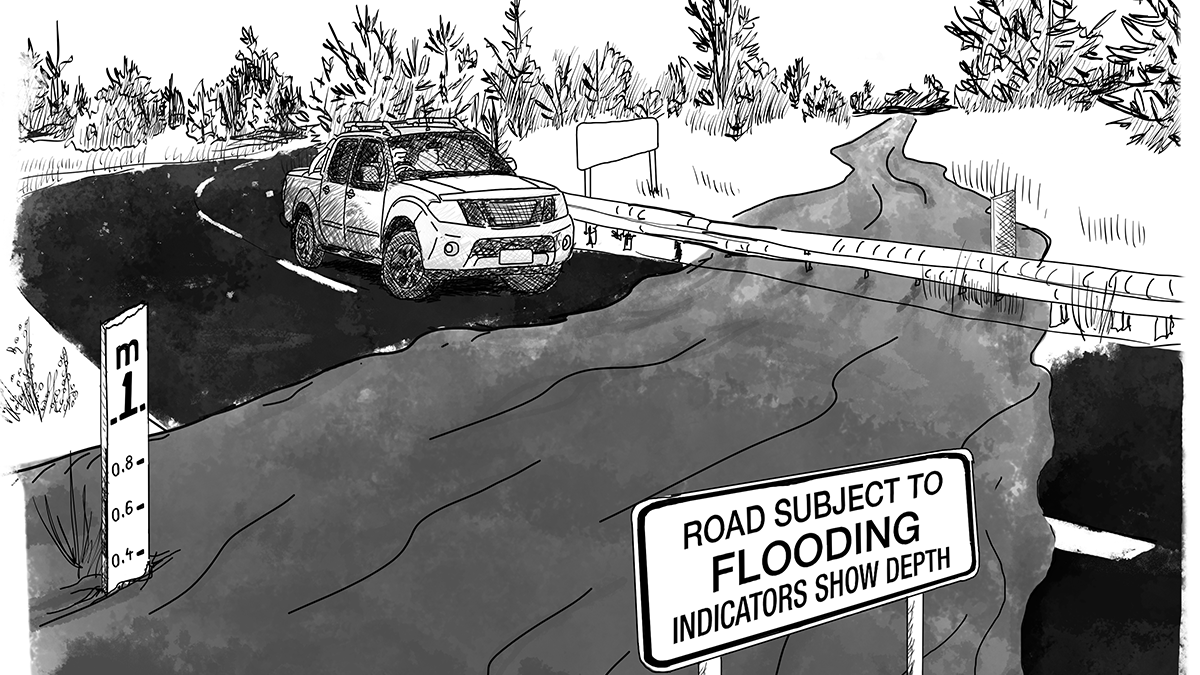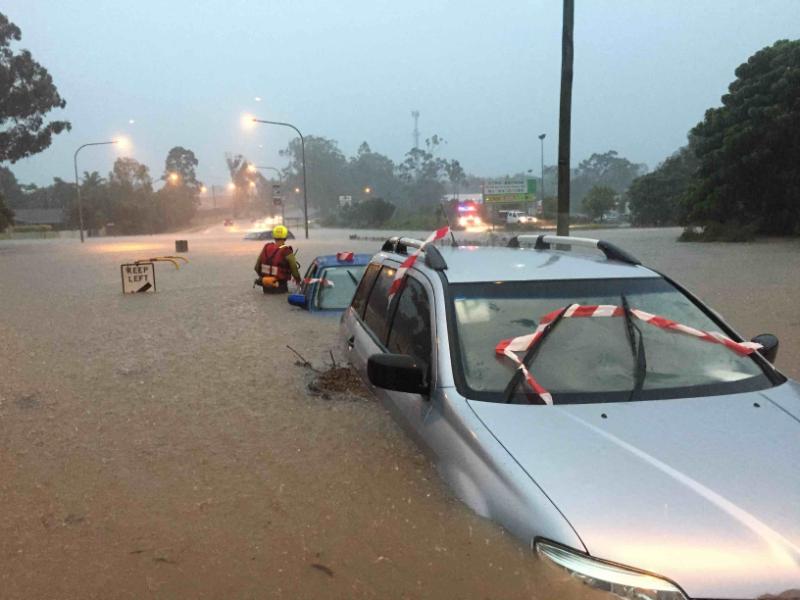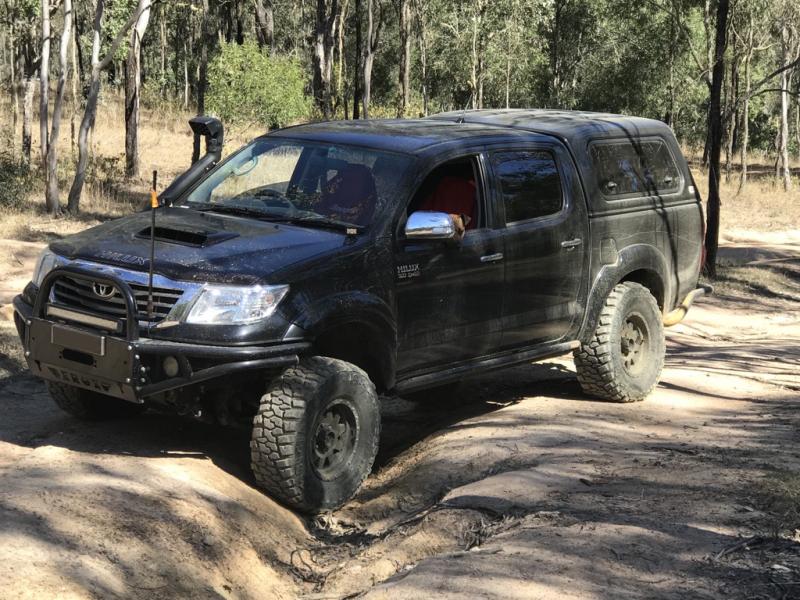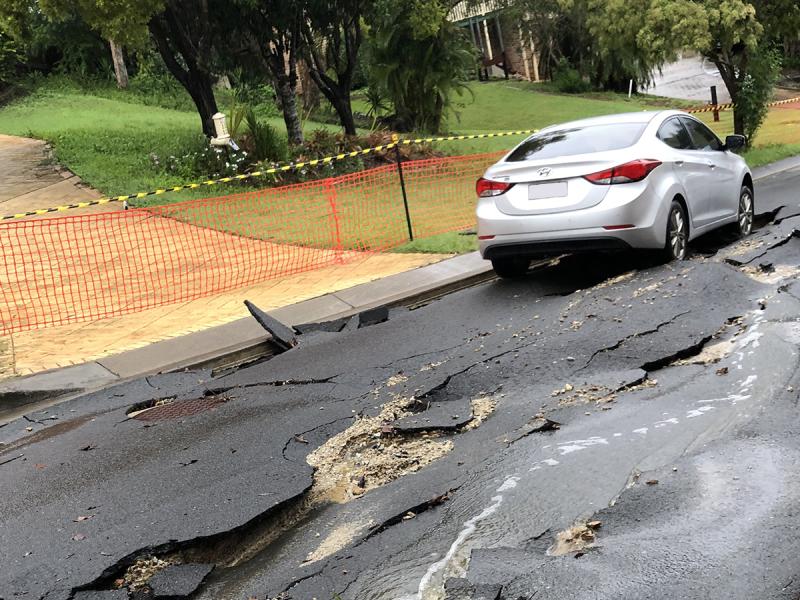Flooding can happen anywhere in Queensland, with waters rising over days, or in minutes in a ‘flash flood’. Driving into floodwater is the number one cause of flood related deaths in Queensland. Floodwater can move quickly and can take you by surprise. It has the power to sweep away your car and rip up the road. It doesn't matter what kind of car you drive: once you enter floodwater, you lose control. The message is clear- if it’s flooded, forget it.
Hover over the interactive dots below or expand the checklist to find out how.
Know the dangers

If you come across a flooded road, the safest thing to do is to stop and turn around.
Often, people who drive into floodwater are following what others are doing or feel pressured to keep driving. Even if you make it through, others who see and follow, might not.
Lead by example and turn around.
Any flooded road can be deadly and the size of your vehicle does not matter.
An unstable road surface can collapse under the weight of your vehicle.
It doesn't matter how experienced you are; avoid entering floodwater at all costs.
Once your car starts floating, you have lost control.
During heavy rain, conditions can be unpredictable and ‘flash’ flooding can develop quickly.
Floodwater over the road can look still but can hide fast flowing water underneath. It can be hard to estimate how deep the water is, or how strong the current can be.
The road may be damaged, drains could be clogged, and sudden dangerous surges of water can occur.
Water on the road can hide deep potholes and damage to roads – including collapsed road surfaces and washed-out drains.
What could be lurking in floodwater?
Dirt, mud, branches, rocks.
Chemicals, bacteria, contaminated sewerage.
Snakes, spiders, dead animals and much much more.
Exposing a scratch or a graze to floodwater can cause infection and serious illness - or even death.
Assume all floodwater is contaminated and stay away.
If you’re driving during wet weather, slow down so you can see and respond more safely to the changing situation around you.
When conditions are bad, it can be hard to tell the difference between a wet road and a flooded road.
Unsealed roads will become slippery. Mud and debris add to dangerous driving conditions.
If you feel unsafe, or if it’s becoming dangerous, safely pull off the road and stop somewhere safe – ideally on higher ground away from trees.
When it’s safe to continue, be aware of mud, debris, damaged roads and fallen trees.
It’s dangerous to drive on flooded roads, causeways, creek crossings, and rural tracks.
Think about alternatives if your ‘usual’ roads are prone to flooding or unsealed. The best way to avoid driving in floodwater is to be prepared – that often means waiting for conditions to improve before heading out.
Take note of flood depth indicators on roads you normally use as these will likely flood in the future.
Always obey road closure signs, even if floodwater has gone down.
Ignoring warning signs can risk your life and could result in fines.
Drive carefully on roads that have been reopened because they may still be drying out.
"Road Subject to Flooding" signs are placed near known flood hotspots to warn drivers.
Don't expect every flooded road to have a warning.
If you come across a flooded road, the safest thing to do is to stop and turn around.
Often, people who drive into floodwater are following what others are doing or feel pressured to keep driving. Even if you make it through, others who see and follow, might not.
Lead by example and turn around.
Any flooded road can be deadly and the size of your vehicle does not matter.
An unstable road surface can collapse under the weight of your vehicle.
It doesn't matter how experienced you are; avoid entering floodwater at all costs.
Once your car starts floating, you have lost control.
During heavy rain, conditions can be unpredictable and ‘flash’ flooding can develop quickly.
Floodwater over the road can look still but can hide fast flowing water underneath. It can be hard to estimate how deep the water is, or how strong the current can be.
The road may be damaged, drains could be clogged, and sudden dangerous surges of water can occur.
Water on the road can hide deep potholes and damage to roads – including collapsed road surfaces and washed-out drains.
What could be lurking in floodwater?
Dirt, mud, branches, rocks.
Chemicals, bacteria, contaminated sewerage.
Snakes, spiders, dead animals and much much more.
Exposing a scratch or a graze to floodwater can cause infection and serious illness - or even death.
Assume all floodwater is contaminated and stay away.
If you’re driving during wet weather, slow down so you can see and respond more safely to the changing situation around you.
When conditions are bad, it can be hard to tell the difference between a wet road and a flooded road.
Unsealed roads will become slippery. Mud and debris add to dangerous driving conditions.
If you feel unsafe, or if it’s becoming dangerous, safely pull off the road and stop somewhere safe – ideally on higher ground away from trees.
When it’s safe to continue, be aware of mud, debris, damaged roads and fallen trees.
It’s dangerous to drive on flooded roads, causeways, creek crossings, and rural tracks.
Think about alternatives if your ‘usual’ roads are prone to flooding or unsealed. The best way to avoid driving in floodwater is to be prepared – that often means waiting for conditions to improve before heading out.
Take note of flood depth indicators on roads you normally use as these will likely flood in the future.
Always obey road closure signs, even if floodwater has gone down.
Ignoring warning signs can risk your life and could result in fines.
Drive carefully on roads that have been reopened because they may still be drying out.
"Road Subject to Flooding" signs are placed near known flood hotspots to warn drivers.
Don't expect every flooded road to have a warning.
If you come across a flooded road, the safest thing to do is to stop and turn around.
Often, people who drive into floodwater are following what others are doing or feel pressured to keep driving. Even if you make it through, others who see and follow, might not.
Lead by example and turn around.
Any flooded road can be deadly and the size of your vehicle does not matter.
An unstable road surface can collapse under the weight of your vehicle.
It doesn't matter how experienced you are; avoid entering floodwater at all costs.
Once your car starts floating, you have lost control.
During heavy rain, conditions can be unpredictable and ‘flash’ flooding can develop quickly.
Floodwater over the road can look still but can hide fast flowing water underneath. It can be hard to estimate how deep the water is, or how strong the current can be.
The road may be damaged, drains could be clogged, and sudden dangerous surges of water can occur.
Water on the road can hide deep potholes and damage to roads – including collapsed road surfaces and washed-out drains.
What could be lurking in floodwater?
Dirt, mud, branches, rocks.
Chemicals, bacteria, contaminated sewerage.
Snakes, spiders, dead animals and much much more.
Exposing a scratch or a graze to floodwater can cause infection and serious illness - or even death.
Assume all floodwater is contaminated and stay away.
If you’re driving during wet weather, slow down so you can see and respond more safely to the changing situation around you.
When conditions are bad, it can be hard to tell the difference between a wet road and a flooded road.
Unsealed roads will become slippery. Mud and debris add to dangerous driving conditions.
If you feel unsafe, or if it’s becoming dangerous, safely pull off the road and stop somewhere safe – ideally on higher ground away from trees.
When it’s safe to continue, be aware of mud, debris, damaged roads and fallen trees.
It’s dangerous to drive on flooded roads, causeways, creek crossings, and rural tracks.
Think about alternatives if your ‘usual’ roads are prone to flooding or unsealed. The best way to avoid driving in floodwater is to be prepared – that often means waiting for conditions to improve before heading out.
Take note of flood depth indicators on roads you normally use as these will likely flood in the future.
Always obey road closure signs, even if floodwater has gone down.
Ignoring warning signs can risk your life and could result in fines.
Drive carefully on roads that have been reopened because they may still be drying out.
"Road Subject to Flooding" signs are placed near known flood hotspots to warn drivers.
Don't expect every flooded road to have a warning.
The true cost of driving into floodwater
Driving into floodwater is the number one cause of flood related deaths in Queensland. Across Australia, research shows some alarming trends about vehicle related flood deaths:
The facts and the fiction
Let's debunk some crucial floodwater driving myths. Your car is no superhero, floods are relentless, and familiarity won't save you. In Queensland, severe weather is here to stay. Understand the difference between fact and fiction when it comes to floodwater.





Hear what the experts have to say
Video: The risks of entering floodwater (Run time: 1 minute 23 seconds)
Video: Reduced risk perception behind the wheel (Run time: 1 minute 33 seconds)
Be prepared
The best way to avoid driving in floodwater is to be prepared. Check if flooding is likely, plan ahead and make alternative arrangements so you are not driving on or near flooded roads.
Pack a vehicle safety kit
Pack a vehicle safety kit to store in your car. Some of these items should be easily accessible from the driver's seat, and some stored safely in the back should you have to pull over and wait it out.

If your car accidently enters deep water and you can't get your window open, breaking it is almost impossible without a vehicle emergency hammer. Be sure to store these items where it can be easily reached from the driver’s seat.
- An emergency hammer
- Waterproof torch or glow sticks
- Foil blanket.
Your vehicle emergency kit, will ensure you are prepared for the unexpected. Keep these in the boot of your car at all times.
- First Aid Kit
- Bottled water and dry food snacks in case you have to stay in situ until it is safe to move
- Torch and spare batteries
- Tow Rope
- Blanket and Tarpaulin to help keep warm and dry in case windows have been damaged.
- Toilet Paper
- Toolkit including the basics to help you fix any simple issues, duct tape, screwdrivers, hammer, ocky/bungee straps.
If your car accidently enters deep water and you can't get your window open, breaking it is almost impossible without a vehicle emergency hammer. Be sure to store these items where it can be easily reached from the driver’s seat.
- An emergency hammer
- Waterproof torch or glow sticks
- Foil blanket.
Your vehicle emergency kit, will ensure you are prepared for the unexpected. Keep these in the boot of your car at all times.
- First Aid Kit
- Bottled water and dry food snacks in case you have to stay in situ until it is safe to move
- Torch and spare batteries
- Tow Rope
- Blanket and Tarpaulin to help keep warm and dry in case windows have been damaged.
- Toilet Paper
- Toolkit including the basics to help you fix any simple issues, duct tape, screwdrivers, hammer, ocky/bungee straps.
If your car accidently enters deep water and you can't get your window open, breaking it is almost impossible without a vehicle emergency hammer. Be sure to store these items where it can be easily reached from the driver’s seat.
- An emergency hammer
- Waterproof torch or glow sticks
- Foil blanket.
Your vehicle emergency kit, will ensure you are prepared for the unexpected. Keep these in the boot of your car at all times.
- First Aid Kit
- Bottled water and dry food snacks in case you have to stay in situ until it is safe to move
- Torch and spare batteries
- Tow Rope
- Blanket and Tarpaulin to help keep warm and dry in case windows have been damaged.
- Toilet Paper
- Toolkit including the basics to help you fix any simple issues, duct tape, screwdrivers, hammer, ocky/bungee straps.


